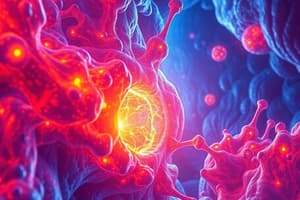Podcast
Questions and Answers
What is the definition of repair?
What is the definition of repair?
Replacement of damaged tissue by new healthy one.
Which of the following are classical types of repair? (Select all that apply)
Which of the following are classical types of repair? (Select all that apply)
- Regeneration (correct)
- Fibrosis (correct)
- Healing by organization
- None of the above
What determines the type of repair?
What determines the type of repair?
- The location of the injury
- The age of the patient
- Type of damaged cells (correct)
- The time since the injury occurred
What are labile cells?
What are labile cells?
What are permanent cells?
What are permanent cells?
How do stable cells heal if damaged?
How do stable cells heal if damaged?
What happens if the normal framework of an organ is destroyed?
What happens if the normal framework of an organ is destroyed?
What is the first phase of healing?
What is the first phase of healing?
Match the following healing processes to their descriptions:
Match the following healing processes to their descriptions:
Granulation tissue is a transient tissue formed during the repair by _____.
Granulation tissue is a transient tissue formed during the repair by _____.
What is the composition of granulation tissue?
What is the composition of granulation tissue?
What essential process supplies nutrition to proliferating fibroblasts during granulation tissue formation?
What essential process supplies nutrition to proliferating fibroblasts during granulation tissue formation?
Fibrosis in the CNS is referred to as gliosis.
Fibrosis in the CNS is referred to as gliosis.
Flashcards
Regeneration
Regeneration
Replacement of damaged tissue with identical healthy tissue
Fibrosis (Gliosis in CNS)
Fibrosis (Gliosis in CNS)
Damaged tissue replaced by fibrous scar tissue; in the brain/spinal cord (CNS) it is called gliosis.
Labile Cells
Labile Cells
Cells that continually divide. If damaged, regenerate.
Permanent Cells
Permanent Cells
Signup and view all the flashcards
Stable Cells
Stable Cells
Signup and view all the flashcards
Granulation Tissue
Granulation Tissue
Signup and view all the flashcards
Healing Phase: Cleaning
Healing Phase: Cleaning
Signup and view all the flashcards
Healing Phase: Proliferation
Healing Phase: Proliferation
Signup and view all the flashcards
Healing Phase: Remodeling
Healing Phase: Remodeling
Signup and view all the flashcards
Bone Fracture Repair
Bone Fracture Repair
Signup and view all the flashcards
Study Notes
Pathology of Repair
- Repair is the replacement of damaged tissue by new, healthy tissue.
Types of Repair
- Classical types:
- Regeneration: Replacing damaged tissue with the same type of tissue
- Fibrosis (Gliosis in CNS): Formation of scar tissue, especially in the central nervous system.
- Other types:
- Organization: Healing of dead or non-living material by granulation tissue, which matures into fibrous tissue
Determinants of Repair Type
- Type of damaged cells:
- Permanent cells: Do not proliferate. Repair by fibrosis (e.g., muscle, nerve).
- Stable cells: Can proliferate but have limited capacity. Repair by mixed regeneration and/or fibrosis (e.g., liver cells, kidney tubular cells, glands).
- Labile cells: Continuously dividing. Repair by regeneration (e.g., epidermis, mucous membranes, blood and lymphoid tissue).
- Supporting framework:
- If the framework remains intact, healing by regeneration occurs.
- If the framework is destroyed, the proliferating cells may display a disorganized pattern mixed with fibrosis.
Phases of Healing
- Cleaning phase: Necrotic debris removal by phagocytic cells.
- Proliferation phase: Repair cells proliferate to replace damaged ones.
- Remodeling phase: The new tissue matures to resemble the original tissue.
Healing by Regeneration
- Definition: Replacement of damaged tissue with healthy tissue of the same kind.
- Cells healing by regeneration: Labile and stable cells (with intact framework).
- Example in skin: Epidermis damage only—regeneration; epithelium & sub-epithelium damage—fibrosis.
- Example in liver: Intact framework—regeneration; destroyed framework—cirrhosis.
Healing by Fibrosis (Gliosis in CNS)
- Definition: Damaged tissue replaced by granulation tissue that matures into fibrous tissue.
- Mechanism:
- Capillaries (neo-vascularization).
- Fibroblasts secrete collagen.
- Fate:
- Collagen fibers reorganization
- Fibroblasts change into fibrocytes.
- Formation of avascular, strong fibrous tissue (scar).
- Examples: Muscle damage (e.g., myocardial infarction), nerve/neuron damage (CNS).
Healing by Organization
- Definition: Healing of dead or non-living material by granulation tissue followed by fibrous tissue.
- Examples: Thrombus, fibrin in sero-fibrinous inflammation.
Healing of Skin Wounds
- Primary union (first intention): Clean incisional wounds; minimal tissue destruction and approximated edges. Characteristics: rapid healing, small scar, complications are rare.
- Secondary union (second intention): Gaping wounds, septic wounds, or abscesses. Characteristics: slow healing, large scar, complications more frequent.
Complications of Repair
- Too little repair: Ulcer, sinus, fistula, weak scar, incisional hernia, fibrous union of bone (pseudo-arthrosis).
- Excessive repair: Excessive granulation tissue, excessive scar tissue, squamous cell carcinoma (rare).
Factors Affecting Repair
- Local factors: Blood supply, foreign bodies, hematoma, infection, cell type, wound size.
- Systemic factors: Age, nutritional status, presence of debilitating diseases, medication.
Studying That Suits You
Use AI to generate personalized quizzes and flashcards to suit your learning preferences.


